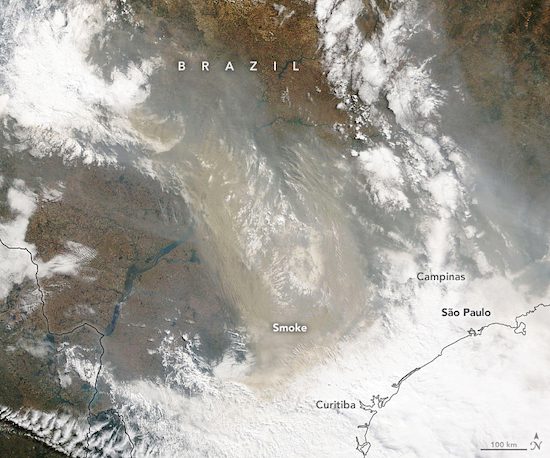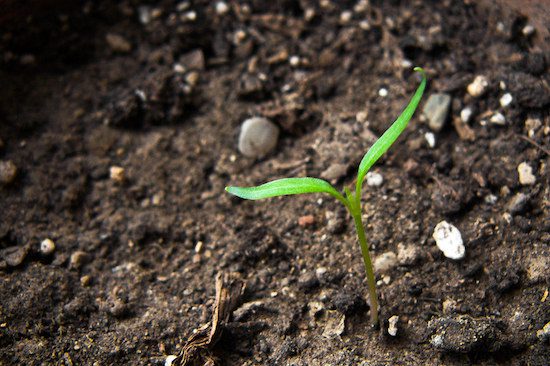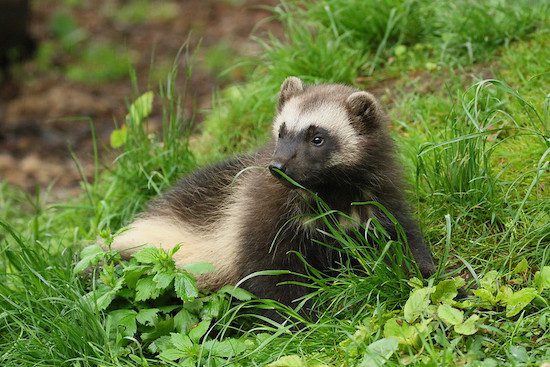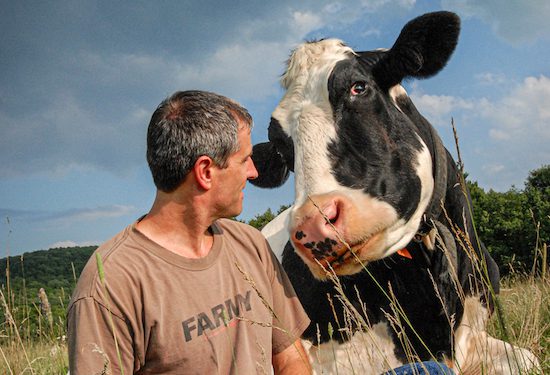


In June, Earth | Food | Life reporter Daniel Ross examined the Brazilian President Jair Bolsonaro’s “aggressive deregulation and increased commercial exploitation of the Amazon’s resources.” Now a new report by Human Rights Watch, the Institute for Health Policy Studies and the Amazon Environmental Research Institute reveal that “unchecked deforestation” from human-created fires “are poisoning the air millions of people breathe, affecting health throughout the Brazilian Amazon.”
Care2: The fires blazing in Brazil’s Amazon rainforest this year are beyond anything we’ve ever seen before. Every year—and now, it seems, every month—it gets worse as more and more people intentionally set fire to the lush, rare habitat that is the Amazon to provide the food that you and I eat. But now more than ever, we need the Amazon rainforest, which is frequently referred to as “the Earth’s lungs.” As this critical ecosystem burns to the ground, not only is climate change ramping up, but the air quality is also declining. Now, the pollution has gotten so bad, people in Brazil are getting sick and dying from it. A recent study shows that the situation has intensified so drastically, there are now thousands of air quality-related hospitalizations in the country just because of the fires alone. This could not come at a worse time, since we are already in the middle of a global respiratory pandemic and Brazil is suffering some of the worst COVID-related fatality rates in the world. The report explains that President Jair Bolsonaro, his administration, and their failure to do anything to stop these human-caused fires are directly at fault for all of this sickness and death. Brazilians can’t afford any more illnesses, and the global community can’t afford any more greenhouse gas-emitting deforestation. These fires must end now.
>>>Demand that the Brazilian government bans human-created fires that are destroying the Amazon rainforest.
Environmental Action: Red wolves ended last year on a hopeful note: A federal judge ruled that the U.S. Fish and Wildlife Service (FWS) is not permitted to capture and kill them. But this story is not over quite yet. We need to make sure the future fulfills last year’s promise that red wolves will be managed in a way that allows them to thrive. One fact hasn’t changed: There are still only a few dozen wild red wolves, and they still need our help. North Carolina’s tiny red wolf population faces terrible threats from natural dangers and humans alike. We know for a fact that the FWS is capable of managing red wolves responsibly—history proves it. Years of hunting once drove red wolves extinct in the wild. But then, over the intervening decades, a remarkable conservation effort took shape: FWS reintroduced them to their natural habitat and protected the delicate new population until their numbers swelled to over 120. But then things changed. Under pressure from private landowners, the FWS altered their management to allow red wolves to be killed. They stopped releasing new animals and monitoring pups’ health. The wild population plummeted again. FWS has not yet announced what its newest revised red wolf management practices will look like. We need to make sure their management plan repeats the proven success of their very first one, or else risk losing these animals forever.
>>>Urge the U.S. Fish and Wildlife Service to use the breadth of their experience and the best possible science in designing their final red wolf management plan.
Change: The city of Denver has a contract with the U.S. Department of Agriculture’s Animal and Plant Health Inspection Service Wildlife Services (APHIS-WS) to kill Canada geese under the misconception that geese droppings contain harmful bacteria. No scientific research supports this notion. “Geese feces are no more dangerous than other feces and probably a lot less so than human feces,” says David E. Stalknecht of the University of Georgia, who co-authored a study on bird droppings for The Centers for Disease Control and Prevention in Atlanta. Geese present no more of a health risk than any other species, including cats and dogs, says Dr. Julia Murphy, public health veterinarian for the Virginia State Department of Health. “Certainly there’s a possibility of pathogens in fecal material, but as a particular risk factor in and of itself, there simply is no direct link,” says Murphy. You would have to ingest droppings to experience discomfort (such as mild gastrointestinal cramps or upset stomach), she adds. “APHIS-WS is a strategically misnamed federal program that wastes millions of taxpayer dollars each year killing wild animals using traps, snares, poisons, gas and aerial gunning,” writes Colorado-based animal activist Ellen Kessler, who started a petition to save the geese. According to their reports, they have slaughtered more than 34 million animals in the last decade alone.
>>>Demand that Denver permanently terminate its contract with APHIS-WS and cease the useless and costly killing of Canada Geese.
Cause for concern…

Last year, Earth | Food | Life reporter Daniel Ross investigated an underexplored solution to climate change: healthy soil, which has a powerful ability to sequester carbon, with three times the holding capacity than the atmosphere. Now a new study by the University of Basel has found that climate change and intensive agriculture could greatly increase soil loss across the globe over the next 50 years. The researchers are calling for more sustainable land cultivation.
- Climate change and land are accelerating soil erosion by water (University of Basel)
- Big Dairy is heating up the planet and hollowing rural communities (Shefali Sharma, Institute for Agriculture & Trade Policy)
- Brazilian Amazon drained of millions of wild animals by criminal networks (Sharon Guynup, Mongabay)
- New study warns: We have underestimated the pace at which the Arctic is melting (University of Copenhagen, Environmental News Network)
- How billions in EU farming subsidies are being misspent (Lund University)
- Big mammals at higher risk of extinction in world’s poorest countries (University of York)
- Water availability has changed, and humans are to blame (CMCC Foundation, Smart Water Magazine)
- COVID-19 pandemic should be a wake-up call for water security (University of Birmingham)
- The wool industry means suffering for sheep (Humane Decisions, Animal People Forum)
- USDA says current poultry food safety guidelines do not stop salmonella outbreaks (Society for Risk Analysis)
Round of applause…

“Conservationists at Mount Rainier National Park in Washington State have spotted a wolverine mother and her two offspring, known as kits,” reports George Dvorsky for Earther. “A reproductive female hasn’t been seen in this national park for over a century, which suggests ecological conditions in the area are improving.”
- Wolverines return to Mount Rainier after 100-year absence (George Dvorsky, Earther)
- U.K. seeks to ban supermarkets selling goods linked to deforestation (Jessica Shankleman, Bloomberg Green)
- Dutch government to shut down all mink farms by next year (The Mainichi)
- Elephant trails may lead the way to better conservation approaches (Purdue University)
- A photographer turned his Mumbai window into a butterfly garden during lockdown (Kiran Mehta, Atlas Obscura)
- University of Adelaide bans inhumane animal testing (News.com.au)
- Pesticide-free crop protection yields up to US$ 20 billion/year benefits in Asia-Pacific (CABI)
- Our son wanted to be vegetarian, and we’re proud he stood up for what he believes in (Beth R, Popsugar)
- Vegan milk no longer just a trend with millennials as third of Britons buy non-dairy alternatives (Helena Horton, The Telegraph)
- Majority of French public wants better treatment for animals, poll says (Mike Woods, RFI)
Parting thought…

“It’s a small thing to help one animal, but to that one animal it’s a big thing,” —Gene Baur
Earth | Food | Life (EFL) explores the critical and often interconnected issues facing the climate/environment, food/agriculture and nature/animal rights, and champions action; specifically, how responsible citizens, voters and consumers can help put society on an ethical path of sustainability that respects the rights of all species who call this planet home. EFL emphasizes the idea that everything is connected, so every decision matters.
Click here to support the work of EFL and the Independent Media Institute.
Questions, comments, suggestions, submissions? Contact EFL editor Reynard Loki at [email protected]. Follow EFL on Twitter @EarthFoodLife.